
Mastering Object-oriented Python. If you want to master object-oriented Python programming this book is a must-have. With 750 code samples and a relaxed tutorial, it’s a seamless route to programming Python Steven F. Lott
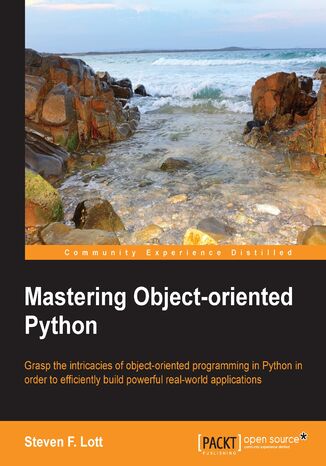



- Autor:
- Steven F. Lott
- Ocena:
- Bądź pierwszym, który oceni tę książkę
- Stron:
- 634
- Dostępne formaty:
-
PDFePubMobi
Opis
książki
:
Mastering Object-oriented Python. If you want to master object-oriented Python programming this book is a must-have. With 750 code samples and a relaxed tutorial, it’s a seamless route to programming Python
Wybrane bestsellery
-
Nowość Promocja
 Ta książka stanowi kompleksowe i obszerne wprowadzenie do języka Python. Pomoże Ci opanować jego podstawy i przygotuje do praktycznego zastosowania nabytej wiedzy. To wydanie zostało zaktualizowane i rozszerzone, aby odzwierciedlić zmiany zachodzące w świecie Pythona. Pominięto omówienie nieaktualnej wersji 2.X,opisano nowe narzędzia, dodane do Pythona w wersji 3.12, a także innych jego edycji, które są dziś szeroko używane.
Ta książka stanowi kompleksowe i obszerne wprowadzenie do języka Python. Pomoże Ci opanować jego podstawy i przygotuje do praktycznego zastosowania nabytej wiedzy. To wydanie zostało zaktualizowane i rozszerzone, aby odzwierciedlić zmiany zachodzące w świecie Pythona. Pominięto omówienie nieaktualnej wersji 2.X,opisano nowe narzędzia, dodane do Pythona w wersji 3.12, a także innych jego edycji, które są dziś szeroko używane.-
ebook
-
książka
99 pkt
(99,50 zł najniższa cena z 30 dni)
99.50 zł
199.00 zł (-50%) -
-
Nowość Promocja
 Dzięki tej książce pewnie wkroczysz do fascynującego świata internetu rzeczy! Zaczniesz od podstaw: poznasz usługi internetowe, komunikację LoRa, porty GPIO, a także możliwości najnowszych mikrokontrolerów Raspberry Pi. Dowiesz się też, czym jest ROS i jak stworzyć projekt oparty na rozpoznawaniu obrazów. Krok po kroku będziesz przechodzić do coraz bardziej zaawansowanych rozwiązań. Nauczysz się integrować aplikacje z usługami sieciowymi i używać technologii LoRa do komunikacji na dużą odległość przy niskim zużyciu energii. Dzięki jasnym instrukcjom i zrozumiałym wyjaśnieniom uzyskasz niezbędne umiejętności, by tworzyć innowacyjne urządzenia IoT.
Dzięki tej książce pewnie wkroczysz do fascynującego świata internetu rzeczy! Zaczniesz od podstaw: poznasz usługi internetowe, komunikację LoRa, porty GPIO, a także możliwości najnowszych mikrokontrolerów Raspberry Pi. Dowiesz się też, czym jest ROS i jak stworzyć projekt oparty na rozpoznawaniu obrazów. Krok po kroku będziesz przechodzić do coraz bardziej zaawansowanych rozwiązań. Nauczysz się integrować aplikacje z usługami sieciowymi i używać technologii LoRa do komunikacji na dużą odległość przy niskim zużyciu energii. Dzięki jasnym instrukcjom i zrozumiałym wyjaśnieniom uzyskasz niezbędne umiejętności, by tworzyć innowacyjne urządzenia IoT.-
ebook
-
książka
69 pkt
(69,50 zł najniższa cena z 30 dni)
69.50 zł
139.00 zł (-50%) -
-
Nowość Promocja
 W czasach, gdy wiele naszych działań przeniosło się do przestrzeni cyfrowej, tworzymy i agregujemy ogromne ilości danych. Przechowujemy je na dyskach urządzeń, mobilnych nośnikach pamięci, w chmurach, a nawet w formie załączników poczty elektronicznej. Aby uzyskać z nich jak najwięcej informacji, musimy wykonywać odpowiednie procesy analityczno-agregujące, które następnie pozwolą nam na wyciągnięcie właściwych wniosków, a potem podjęcie odpowiednich decyzji. W tym miejscu często pojawia się problem: w jaki sposób pogodzić różne formaty danych, odpowiednio je ze sobą połączyć, wykonać mapowanie i konwertowanie?
W czasach, gdy wiele naszych działań przeniosło się do przestrzeni cyfrowej, tworzymy i agregujemy ogromne ilości danych. Przechowujemy je na dyskach urządzeń, mobilnych nośnikach pamięci, w chmurach, a nawet w formie załączników poczty elektronicznej. Aby uzyskać z nich jak najwięcej informacji, musimy wykonywać odpowiednie procesy analityczno-agregujące, które następnie pozwolą nam na wyciągnięcie właściwych wniosków, a potem podjęcie odpowiednich decyzji. W tym miejscu często pojawia się problem: w jaki sposób pogodzić różne formaty danych, odpowiednio je ze sobą połączyć, wykonać mapowanie i konwertowanie?-
ebook
-
książka
29 pkt
(29,49 zł najniższa cena z 30 dni)
29.49 zł
59.00 zł (-50%) -
-
Promocja
 Stuck in a coding conundrum? Whether you're an advanced beginner, an intermediate developer, or a curious newcomer, the complexities of coding can often feel like a labyrinth with no exit. With Python, however, you can start writing real code quickly—but where should you start? In this updated third edition, Bill Lubanovic acts as your personal gu
Stuck in a coding conundrum? Whether you're an advanced beginner, an intermediate developer, or a curious newcomer, the complexities of coding can often feel like a labyrinth with no exit. With Python, however, you can start writing real code quickly—but where should you start? In this updated third edition, Bill Lubanovic acts as your personal gu-
-
ebook
143 pkt
(29,90 zł najniższa cena z 30 dni)
143.65 zł
169.00 zł (-15%) -
-
Promocja
 Ta książka jest zwięzłym wprowadzeniem do głównych zagadnień i aspektów uczenia przez wzmacnianie i algorytmów DQL. Docenią ją zarówno naukowcy, jak i praktycy poszukujący skutecznych algorytmów, przydatnych w pracy z finansami. Znajdziesz tu wiele interesujących przykładów w języku Python, zaprezentowanych w formie najciekawszych algorytmów gotowych do samodzielnego modyfikowania i testowania.
Ta książka jest zwięzłym wprowadzeniem do głównych zagadnień i aspektów uczenia przez wzmacnianie i algorytmów DQL. Docenią ją zarówno naukowcy, jak i praktycy poszukujący skutecznych algorytmów, przydatnych w pracy z finansami. Znajdziesz tu wiele interesujących przykładów w języku Python, zaprezentowanych w formie najciekawszych algorytmów gotowych do samodzielnego modyfikowania i testowania.-
ebook
-
książka
39 pkt
(39,50 zł najniższa cena z 30 dni)
39.50 zł
79.00 zł (-50%) -
-
Promocja
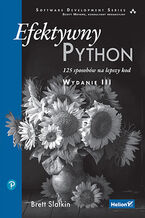 To trzecie, zaktualizowane i uzupełnione wydanie lubianego podręcznika programowania w Pythonie. Zawiera dodatkowe rozdziały dotyczące tak ważnych zagadnień jak algorytmy i struktury danych. Zawarty w książce materiał, w tym słowniki , ułatwi Ci tworzenie solidnego i wydajnego kodu. Znajdziesz tu jasne, zwięzłe i praktyczne rady przeznaczone dla programistów na różnym poziomie zaawansowania. Niezależnie od tego, czy tworzysz aplikacje internetowe, analizujesz dane, czy trenujesz modele sztucznej inteligencji, dzięki temu podręcznikowi zdobędziesz cenne umiejętności pracy z Pythonem!
To trzecie, zaktualizowane i uzupełnione wydanie lubianego podręcznika programowania w Pythonie. Zawiera dodatkowe rozdziały dotyczące tak ważnych zagadnień jak algorytmy i struktury danych. Zawarty w książce materiał, w tym słowniki , ułatwi Ci tworzenie solidnego i wydajnego kodu. Znajdziesz tu jasne, zwięzłe i praktyczne rady przeznaczone dla programistów na różnym poziomie zaawansowania. Niezależnie od tego, czy tworzysz aplikacje internetowe, analizujesz dane, czy trenujesz modele sztucznej inteligencji, dzięki temu podręcznikowi zdobędziesz cenne umiejętności pracy z Pythonem!-
ebook
-
książka
69 pkt
(69,50 zł najniższa cena z 30 dni)
69.50 zł
139.00 zł (-50%) -
-
Promocja
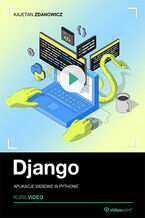 Chcesz wejść do świata IT i szybko zobaczyć efekty swojej nauki? Postaw na framework Django, który pozwala budować nowoczesne, bezpieczne i skalowalne aplikacje webowe. Dzięki przejrzystej strukturze i ogromnej liczbie gotowych komponentów Django idealnie nadaje się dla początkujących, ale spełnia też oczekiwania profesjonalistów. Nie bez powodu korzystali z niego tacy giganci jak Instagram czy nawet NASA – to narzędzie, które sprawdza się nawet przy najbardziej wymagających projektach. Firmy potrzebują osób, które potrafią szybko zbudować i rozwijać aplikacje, by reagować na potrzeby rynku. Znajomość Django to także krok w stronę wyższych stanowisk i lepszych stawek. Wielu senior developerów zaczynało właśnie od tego frameworka. Jeśli marzysz o awansie, niezależności i projektach, które robią różnicę, zacznij od Django i buduj swoją przyszłość już teraz.
Chcesz wejść do świata IT i szybko zobaczyć efekty swojej nauki? Postaw na framework Django, który pozwala budować nowoczesne, bezpieczne i skalowalne aplikacje webowe. Dzięki przejrzystej strukturze i ogromnej liczbie gotowych komponentów Django idealnie nadaje się dla początkujących, ale spełnia też oczekiwania profesjonalistów. Nie bez powodu korzystali z niego tacy giganci jak Instagram czy nawet NASA – to narzędzie, które sprawdza się nawet przy najbardziej wymagających projektach. Firmy potrzebują osób, które potrafią szybko zbudować i rozwijać aplikacje, by reagować na potrzeby rynku. Znajomość Django to także krok w stronę wyższych stanowisk i lepszych stawek. Wielu senior developerów zaczynało właśnie od tego frameworka. Jeśli marzysz o awansie, niezależności i projektach, które robią różnicę, zacznij od Django i buduj swoją przyszłość już teraz.-
kurs
47 pkt
(83,30 zł najniższa cena z 30 dni)
47.60 zł
119.00 zł (-60%) -
-
Promocja
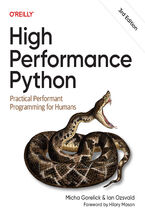 Your Python code may run correctly, but what if you need it to run faster? This practical book shows you how to locate performance bottlenecks and significantly speed up your code in high-data-volume programs. By explaining the fundamental theory behind design choices, this expanded edition of High Performance Python helps experienced Python progra
Your Python code may run correctly, but what if you need it to run faster? This practical book shows you how to locate performance bottlenecks and significantly speed up your code in high-data-volume programs. By explaining the fundamental theory behind design choices, this expanded edition of High Performance Python helps experienced Python progra-
-
ebook
186 pkt
(29,90 zł najniższa cena z 30 dni)
186.15 zł
219.00 zł (-15%) -
-
Promocja
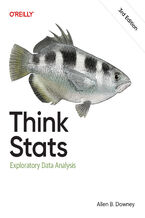 If you know how to program, you have the skills to turn data into knowledge. This thoroughly revised edition presents statistical concepts computationally, rather than mathematically, using programs written in Python. Through practical examples and exercises based on real-world datasets, you'll learn the entire process of exploratory data analysis—
If you know how to program, you have the skills to turn data into knowledge. This thoroughly revised edition presents statistical concepts computationally, rather than mathematically, using programs written in Python. Through practical examples and exercises based on real-world datasets, you'll learn the entire process of exploratory data analysis—-
-
ebook
228 pkt
(29,90 zł najniższa cena z 30 dni)
228.65 zł
269.00 zł (-15%) -
-
Promocja
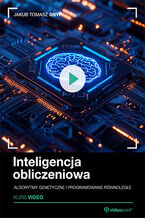 Inteligencja obliczeniowa w machine learning (ML) to zbiór zaawansowanych technik, za sprawą których komputery mogą rozwiązywać złożone problemy, ucząc się z danych, zamiast polegać na regułach programowania. Dzięki algorytmom genetycznym, inspirowanym naturalną ewolucją, można optymalizować procesy w różnych branżach – od inżynierii, przez biotechnologię, aż po logistykę – bez potrzeby tworzenia dużych baz danych. Algorytmy te pozwalają na rozwiązywanie problemów takich jak dopasowywanie parametrów w symulacjach czy optymalizacja tras, co ma szerokie zastosowanie w codziennych wyzwaniach biznesowych.
Inteligencja obliczeniowa w machine learning (ML) to zbiór zaawansowanych technik, za sprawą których komputery mogą rozwiązywać złożone problemy, ucząc się z danych, zamiast polegać na regułach programowania. Dzięki algorytmom genetycznym, inspirowanym naturalną ewolucją, można optymalizować procesy w różnych branżach – od inżynierii, przez biotechnologię, aż po logistykę – bez potrzeby tworzenia dużych baz danych. Algorytmy te pozwalają na rozwiązywanie problemów takich jak dopasowywanie parametrów w symulacjach czy optymalizacja tras, co ma szerokie zastosowanie w codziennych wyzwaniach biznesowych.-
kurs
119 pkt
(209,30 zł najniższa cena z 30 dni)
119.59 zł
299.00 zł (-60%) -
O autorze książki
Steven F. Lott ma blisko pięćdziesiąt lat doświadczenia w programowaniu — kiedy rozpoczynał przygodę z kodem, komputery były duże, drogie i rzadkie. Od ponad dziesięciu lat używa Pythona do rozwiązywania problemów biznesowych; napisał kilka cenionych książek o tym języku. Obecnie jest technomadą . Mieszka na wschodnim wybrzeżu USA.
Steven F. Lott - pozostałe książki
-
Promocja
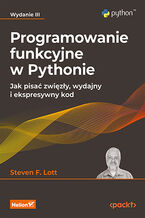 Dzięki temu praktycznemu podręcznikowi zrozumiesz, kiedy i dlaczego warto zastosować myślenie funkcyjne, a także jak korzystać z technik funkcyjnych w różnych scenariuszach. Dowiesz się również, jakie narzędzia i biblioteki przeznaczone do tego celu są dostępne w Pythonie i jak używać wyrażeń generatorowych, list składanych i dekoratorów. W tym wydaniu znalazły się nowe rozdziały dotyczące złożonych obiektów bezstanowych, funkcji kombinatorycznych i pakietu toolz, zawierającego zbiór modułów wspomagających pisanie programów funkcyjnych. Umieszczono tu ponadto sporo ciekawych przykładów, dotyczących choćby eksploracyjnej analizy danych i ich czyszczenia.
Dzięki temu praktycznemu podręcznikowi zrozumiesz, kiedy i dlaczego warto zastosować myślenie funkcyjne, a także jak korzystać z technik funkcyjnych w różnych scenariuszach. Dowiesz się również, jakie narzędzia i biblioteki przeznaczone do tego celu są dostępne w Pythonie i jak używać wyrażeń generatorowych, list składanych i dekoratorów. W tym wydaniu znalazły się nowe rozdziały dotyczące złożonych obiektów bezstanowych, funkcji kombinatorycznych i pakietu toolz, zawierającego zbiór modułów wspomagających pisanie programów funkcyjnych. Umieszczono tu ponadto sporo ciekawych przykładów, dotyczących choćby eksploracyjnej analizy danych i ich czyszczenia.-
ebook
-
książka
44 pkt
(44,50 zł najniższa cena z 30 dni)
44.50 zł
89.00 zł (-50%) -
-
Promocja
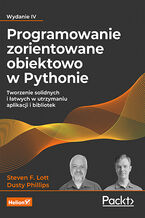 Oto przyjazny przewodnik dla programistów Pythona, wyczerpująco wyjaśniający wiele zagadnień programowania obiektowego, takich jak dziedziczenie, kompozycja, polimorfizm, tworzenie klas i struktur danych. W książce szczegółowo omówiono zagadnienia obsługi wyjątków, testowania kodu i zastosowania technik programowania funkcyjnego. Opisano też dwa potężne zautomatyzowane systemy testowe: unittest i pytest. Zaprezentowano tematykę utrzymania złożonego oprogramowania napisanego w sposób zorientowany obiektowo, a także podano wskazówki odnoszące się do jego rozbudowy. Ważną częścią przewodnika jest omówienie zasad programowania współbieżnego we współczesnym Pythonie. Co ważne, poszczególne zagadnienia zostały zilustrowane diagramami UML, czytelnymi przykładami i studiami przypadków.
Oto przyjazny przewodnik dla programistów Pythona, wyczerpująco wyjaśniający wiele zagadnień programowania obiektowego, takich jak dziedziczenie, kompozycja, polimorfizm, tworzenie klas i struktur danych. W książce szczegółowo omówiono zagadnienia obsługi wyjątków, testowania kodu i zastosowania technik programowania funkcyjnego. Opisano też dwa potężne zautomatyzowane systemy testowe: unittest i pytest. Zaprezentowano tematykę utrzymania złożonego oprogramowania napisanego w sposób zorientowany obiektowo, a także podano wskazówki odnoszące się do jego rozbudowy. Ważną częścią przewodnika jest omówienie zasad programowania współbieżnego we współczesnym Pythonie. Co ważne, poszczególne zagadnienia zostały zilustrowane diagramami UML, czytelnymi przykładami i studiami przypadków.-
ebook
-
książka
74 pkt
(74,50 zł najniższa cena z 30 dni)
74.50 zł
149.00 zł (-50%) -
-
Promocja
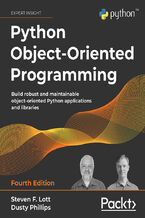 Being familiar with object-oriented design is an essential part of programming in Python. This new edition includes all the topics that made Python Object-Oriented Programming an instant Packt classic. Moreover, it’s packed with updated content to reflect more recent changes in the core Python libraries and cover modern third-party packages.
Being familiar with object-oriented design is an essential part of programming in Python. This new edition includes all the topics that made Python Object-Oriented Programming an instant Packt classic. Moreover, it’s packed with updated content to reflect more recent changes in the core Python libraries and cover modern third-party packages.-
-
ebook
116 pkt
(29,90 zł najniższa cena z 30 dni)
116.10 zł
129.00 zł (-10%) -
-
Promocja
 Python is a great language that can power your applications with great speed, safety, and scalability. We cover 133 Python recipes. This book simplifies Python for everybody, right from beginners to experts. All recipes take a problem-solution approach to resolve issues commonly faced by Python programmers across the globe.
Python is a great language that can power your applications with great speed, safety, and scalability. We cover 133 Python recipes. This book simplifies Python for everybody, right from beginners to experts. All recipes take a problem-solution approach to resolve issues commonly faced by Python programmers across the globe.-
-
ebook
233 pkt
(29,90 zł najniższa cena z 30 dni)
233.10 zł
259.00 zł (-10%) -
-
Promocja
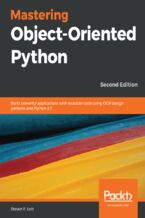 Mastering Object-Oriented Python, Second Edition, will introduce the advanced features of the Python programming language to create the highest quality Python programs possible. This means exploring design alternatives and determining which design offers the best performance, while still being a good fit with the problem being solved.
Mastering Object-Oriented Python, Second Edition, will introduce the advanced features of the Python programming language to create the highest quality Python programs possible. This means exploring design alternatives and determining which design offers the best performance, while still being a good fit with the problem being solved.-
-
ebook
107 pkt
(29,90 zł najniższa cena z 30 dni)
107.10 zł
119.00 zł (-10%) -
-
Promocja
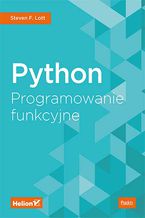 To znakomity podręcznik dla programistów, którzy chcą wykorzystać techniki i wzorce projektowe z funkcyjnych języków programowania, aby tworzyć w Pythonie zwięzłe, eleganckie i ekspresyjne programy — z czytelnym i łatwym w utrzymaniu kodem. Zawiera ogólny przegląd koncepcji funkcyjnych oraz wyjaśnia tak istotne pojęcia jak funkcje pierwszej klasy, funkcje wyższego rzędu, funkcje czyste, leniwe wartościowanie i wiele innych. Wnikliwie omawia sposób korzystania z tych funkcji w Pythonie 3.6, a także techniki przygotowywania i eksploracji danych. Ponadto pokazuje, w jaki sposób standardowa biblioteka Pythona pasuje do funkcyjnego modelu programowania. Co ważne, w książce znalazło się kilka przykładów prezentujących w praktyce opisane koncepcje.
To znakomity podręcznik dla programistów, którzy chcą wykorzystać techniki i wzorce projektowe z funkcyjnych języków programowania, aby tworzyć w Pythonie zwięzłe, eleganckie i ekspresyjne programy — z czytelnym i łatwym w utrzymaniu kodem. Zawiera ogólny przegląd koncepcji funkcyjnych oraz wyjaśnia tak istotne pojęcia jak funkcje pierwszej klasy, funkcje wyższego rzędu, funkcje czyste, leniwe wartościowanie i wiele innych. Wnikliwie omawia sposób korzystania z tych funkcji w Pythonie 3.6, a także techniki przygotowywania i eksploracji danych. Ponadto pokazuje, w jaki sposób standardowa biblioteka Pythona pasuje do funkcyjnego modelu programowania. Co ważne, w książce znalazło się kilka przykładów prezentujących w praktyce opisane koncepcje.-
ebook
-
książka
33 pkt
(33,50 zł najniższa cena z 30 dni)
33.50 zł
67.00 zł (-50%) -
-
Promocja
 Do you feel you’ve mastered the Python language and you know everything it takes to write applications that are a class apart? Well, you’re in for a surprise! This book covers the darkest secrets of Python, delving into its depths and uncovering things you never would have thought could be done.
Do you feel you’ve mastered the Python language and you know everything it takes to write applications that are a class apart? Well, you’re in for a surprise! This book covers the darkest secrets of Python, delving into its depths and uncovering things you never would have thought could be done.-
-
ebook
134 pkt
(29,90 zł najniższa cena z 30 dni)
134.10 zł
149.00 zł (-10%) -
-
Promocja
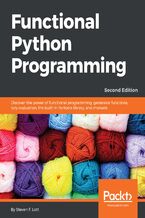 Python is an easy-to-learn and extensible programming language that offers a number of functional programming features. This practical guide demonstrates the Python implementation of a number of functional programming techniques and design patterns. Through this book, you’ll understand what functional programming is all about, its impact on the programming workflow, why it's important, and how to implement it in Python.
Python is an easy-to-learn and extensible programming language that offers a number of functional programming features. This practical guide demonstrates the Python implementation of a number of functional programming techniques and design patterns. Through this book, you’ll understand what functional programming is all about, its impact on the programming workflow, why it's important, and how to implement it in Python.-
-
ebook
134 pkt
(29,90 zł najniższa cena z 30 dni)
134.10 zł
149.00 zł (-10%) -
-
Promocja
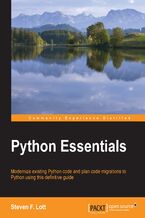
-
-
ebook
107 pkt
(29,90 zł najniższa cena z 30 dni)
107.10 zł
119.00 zł (-10%) -
-
Promocja
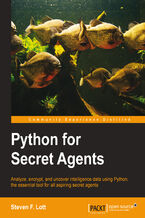
-
-
ebook
80 pkt
(29,90 zł najniższa cena z 30 dni)
80.91 zł
89.90 zł (-10%) -
Ebooka "Mastering Object-oriented Python. If you want to master object-oriented Python programming this book is a must-have. With 750 code samples and a relaxed tutorial, it’s a seamless route to programming Python" przeczytasz na:
-
czytnikach Inkbook, Kindle, Pocketbook, Onyx Boox i innych
-
systemach Windows, MacOS i innych
-
systemach Windows, Android, iOS, HarmonyOS
-
na dowolnych urządzeniach i aplikacjach obsługujących formaty: PDF, EPub, Mobi
Masz pytania? Zajrzyj do zakładki Pomoc »
Szczegóły książki
- Tytuł oryginału:
- Mastering Object-oriented Python. If you want to master object-oriented Python programming this book is a must-have. With 750 code samples and a relaxed tutorial, it’s a seamless route to programming Python.
- ISBN Ebooka:
- 978-17-832-8098-8, 9781783280988
- Data wydania ebooka :
-
2014-04-22
 Data wydania ebooka często jest dniem wprowadzenia tytułu do sprzedaży i może nie być równoznaczna
z datą wydania książki papierowej. Dodatkowe informacje możesz znaleźć w darmowym fragmencie.
Jeśli masz wątpliwości skontaktuj się z nami sklep@ebookpoint.pl.
Data wydania ebooka często jest dniem wprowadzenia tytułu do sprzedaży i może nie być równoznaczna
z datą wydania książki papierowej. Dodatkowe informacje możesz znaleźć w darmowym fragmencie.
Jeśli masz wątpliwości skontaktuj się z nami sklep@ebookpoint.pl.
- Język publikacji:
- angielski
- Rozmiar pliku Pdf:
- 3.2MB
- Rozmiar pliku ePub:
- 930.6kB
- Rozmiar pliku Mobi:
- 3MB
Dostępność produktu
Produkt nie został jeszcze oceniony pod kątem ułatwień dostępu lub nie podano żadnych informacji o ułatwieniach dostępu lub są one niewystarczające. Prawdopodobnie Wydawca/Dostawca jeszcze nie umożliwił dokonania walidacji produktu lub nie przekazał odpowiednich informacji na temat jego dostępności.
Spis treści książki
- Mastering Object-oriented Python
- Table of Contents
- Mastering Object-oriented Python
- Credits
- About the Author
- About the Reviewers
- www.PacktPub.com
- Support files, eBooks, discount offers and more
- Why Subscribe?
- Free Access for Packt account holders
- Support files, eBooks, discount offers and more
- Preface
- What this book covers
- What you need for this book
- Who this book is for
- Conventions
- Reader feedback
- Customer support
- Downloading the example code for this book
- Errata
- Piracy
- Questions
- Some Preliminaries
- About casino Blackjack
- Playing the game
- Blackjack player strategies
- Object design for simulating Blackjack
- Performance the timeit module
- Testing unittest and doctest
- Unit testing and technology spikes
- Docstrings RST markup and documentation tools
- The IDE question
- About special method names
- Summary
- About casino Blackjack
- 1. Pythonic Classes via Special Methods
- Pythonic Classes via Special Methods
- 1. The __init__() Method
- The implicit superclass object
- The base class object __init__() method
- Implementing __init__() in a superclass
- Using __init__() to create manifest constants
- Leveraging __init__() via a factory function
- Faulty factory design and the vague else clause
- Simplicity and consistency using elif sequences
- Simplicity using mapping and class objects
- Two parallel mappings
- Mapping to a tuple of values
- The partial function solution
- Fluent APIs for factories
- Implementing __init__() in each subclass
- Simple composite objects
- Wrapping a collection class
- Extending a collection class
- More requirements and another design
- Complex composite objects
- Complete composite object initialization
- Stateless objects without __init__()
- Some additional class definitions
- Multi-strategy __init__()
- More complex initialization alternatives
- Initializing static methods
- Yet more __init__() techniques
- Initialization with type validation
- Initialization, encapsulation, and privacy
- Summary
- 2. Integrating Seamlessly with Python Basic Special Methods
- The __repr__() and __str__() methods
- Non collection __str__() and __repr__()
- Collection __str__() and __repr__()
- The __format__() method
- Nested formatting specifications
- Collections and delegating format specifications
- The __hash__() method
- Deciding what to hash
- Inheriting definitions for immutable objects
- Overriding definitions for immutable objects
- Overriding definitions for mutable objects
- Making a frozen hand from a mutable hand
- The __bool__() method
- The __bytes__() method
- The comparison operator methods
- Designing comparisons
- Implementation of comparison for objects of the same class
- Implementation of comparison for objects of mixed classes
- Hard totals, soft totals, and polymorphism
- A mixed class comparison example
- The __del__() method
- The reference count and destruction
- Circular references and garbage collection
- Circular references and the weakref module
- The __del__() and close() methods
- The __new__() method and immutable objects
- The __new__() method and metaclasses
- Metaclass example 1 ordered attributes
- Metaclass example 2 self-reference
- Summary
- The __repr__() and __str__() methods
- 3. Attribute Access, Properties, and Descriptors
- Basic attribute processing
- Attributes and the __init__() method
- Creating properties
- Eagerly computed properties
- Setter and deleter properties
- Using special methods for attribute access
- Creating immutable objects with __slots__
- Creating immutable objects as a tuple subclass
- Eagerly computed attributes
- The __getattribute__() method
- Creating descriptors
- Using a nondata descriptor
- Using a data descriptor
- Summary, design considerations, and trade-offs
- Properties versus attributes
- Designing with descriptors
- Looking forward
- Basic attribute processing
- 4. The ABCs of Consistent Design
- Abstract base classes
- Base classes and polymorphism
- Callables
- Containers and collections
- Numbers
- Some additional abstractions
- The iterator abstraction
- Contexts and context managers
- The abc module
- Summary, design considerations, and trade-offs
- Looking forward
- 5. Using Callables and Contexts
- Designing with ABC callables
- Improving performance
- Using memoization or caching
- Using functools for memoization
- Aiming for simplicity using the callable API
- Complexities and the callable API
- Managing contexts and the with statement
- Using the decimal context
- Other contexts
- Defining the __enter__() and __exit__() methods
- Handling exceptions
- Context manager as a factory
- Cleaning up in a context manager
- Summary
- Callable design considerations and trade-offs
- Context manager design considerations and trade-offs
- Looking forward
- 6. Creating Containers and Collections
- ABCs of collections
- Examples of special methods
- Using the standard library extensions
- The namedtuple() function
- The deque class
- The ChainMap use case
- The OrderedDict collection
- The defaultdict subclass
- The counter collection
- Creating new kinds of collections
- Defining a new kind of sequence
- A statistical list
- Choosing eager versus lazy calculation
- Working with __getitem__(), __setitem__(), __delitem__(), and slices
- Implementing __getitem__(), __setitem__(), and __delitem__()
- Wrapping a list and delegating
- Creating iterators with __iter__()
- Creating a new kind of mapping
- Creating a new kind of set
- Some design rationale
- Defining the Tree class
- Defining the TreeNode class
- Demonstrating the binary tree set
- Summary
- Design considerations and Trade-offs
- Looking forward
- 7. Creating Numbers
- ABCs of numbers
- Deciding which types to use
- The method resolution and the reflected operator concept
- The arithmetic operators special methods
- Creating a numeric class
- Defining FixedPoint initialization
- Defining FixedPoint binary arithmetic operators
- Defining FixedPoint unary arithmetic operators
- Implementing FixedPoint reflected operators
- Implementing FixedPoint comparison operators
- Computing a numeric hash
- Designing more useful rounding
- Implementing other special methods
- Optimization with the in-place operators
- Summary
- Design considerations and trade-offs
- Looking forward
- ABCs of numbers
- 8. Decorators and Mixins Cross-cutting Aspects
- Class and meaning
- Constructing the functions
- Constructing the class
- Some class design principles
- Aspect-oriented programming
- Using built-in decorators
- Using standard library decorators
- Using standard library mixin classes
- Using the context manager mixin class
- Turning off a class feature
- Writing a simple function decorator
- Creating separate loggers
- Parameterizing a decorator
- Creating a method function decorator
- Creating a class decorator
- Adding method functions to a class
- Using decorators for security
- Summary
- Design considerations and trade-offs
- Looking forward
- Class and meaning
- 2. Persistence and Serialization
- Persistence and Serialization
- 9. Serializing and Saving JSON, YAML, Pickle, CSV, and XML
- Understanding persistence, class, state, and representation
- Common Python terminologies
- Filesystem and network considerations
- Defining classes to support persistence
- Rendering a blog and posts
- Dumping and loading with JSON
- Supporting JSON in our classes
- Customizing JSON encoding
- Customizing JSON decoding
- The security and the eval() issue
- Refactoring the encode function
- Standardizing the date string
- Writing JSON to a file
- Dumping and loading with YAML
- Formatting YAML data on a file
- Extending the YAML representation
- Security and safe loading
- Dumping and loading with pickle
- Designing a class for reliable pickle processing
- Security and the global issue
- Dumping and loading with CSV
- Dumping simple sequences to CSV
- Loading simple sequences from CSV
- Handling containers and complex classes
- Dumping and loading multiple row types in a CSV file
- Filtering CSV rows with an iterator
- Dumping and loading joined rows in a CSV file
- Dumping and loading with XML
- Dumping objects using string templates
- Dumping objects with xml.etree.ElementTree
- Loading XML documents
- Summary
- Design considerations and trade-offs
- Schema evolution
- Looking forward
- Understanding persistence, class, state, and representation
- 10. Storing and Retrieving Objects via Shelve
- Analyzing persistent object use cases
- The ACID properties
- Creating a shelf
- Designing shelvable objects
- Designing keys for our objects
- Generating surrogate keys for objects
- Designing a class with a simple key
- Designing classes for containers or collections
- Referring to objects via foreign keys
- Designing CRUD operations for complex objects
- Searching, scanning, and querying
- Designing an access layer for shelve
- Writing a demonstration script
- Creating indexes to improve efficiency
- Creating top-level indices
- Adding yet more index maintenance
- The writeback alternative to index updates
- Schema evolution
- Summary
- Design considerations and trade-offs
- Application software layers
- Looking forward
- Analyzing persistent object use cases
- 11. Storing and Retrieving Objects via SQLite
- SQL databases, persistence, and objects
- The SQL data model rows and tables
- CRUD processing via SQL DML statements
- Querying rows with the SQL SELECT statement
- SQL transactions and the ACID properties
- Designing primary and foreign database keys
- Processing application data with SQL
- Implementing class-like processing in pure SQL
- Mapping Python objects to SQLite BLOB columns
- Mapping Python objects to database rows manually
- Designing an access layer for SQLite
- Implementing container relationships
- Improving performance with indices
- Adding an ORM layer
- Designing ORM-friendly classes
- Building the schema with the ORM layer
- Manipulating objects with the ORM layer
- Querying post objects given a tag string
- Improving performance with indices
- Schema evolution
- Summary
- Design considerations and trade-offs
- Mapping alternatives
- Keys and key designs
- Application software layers
- Looking forward
- SQL databases, persistence, and objects
- 12. Transmitting and Sharing Objects
- Class, state, and representation
- Using HTTP and REST to transmit objects
- Implementing CRUD operations via REST
- Implementing non-CRUD operations
- The REST protocol and ACID
- Choosing a representation JSON, XML, or YAML
- Implementing a REST server WSGI and mod_wsgi
- Creating a simple REST application and server
- Implementing a REST client
- Demonstrating and unit testing the RESTful services
- Using Callable classes for WSGI applications
- Designing RESTful object identifiers
- Multiple layers of REST services
- Creating the roulette server
- Creating the roulette client
- Creating a secure REST service
- The WSGI Authentication application
- Implementing REST with a web application framework
- Using a message queue to transmit objects
- Defining processes
- Building queues and supplying data
- Summary
- Design considerations and trade-offs
- Schema evolution
- Application software layers
- Looking forward
- 13. Configuration Files and Persistence
- Configuration file use cases
- Representation, persistence, state, and usability
- Application configuration design patterns
- Configuring via object construction
- Implementing a configuration hierarchy
- Storing the configuration in the INI files
- Handling more literals via the eval() variants
- Storing the configuration in PY files
- Configuration via class definitions
- Configuration via SimpleNamespace
- Using Python with exec() for the configuration
- Why is exec() a nonproblem?
- Using ChainMap for defaults and overrides
- Storing the configuration in JSON or YAML files
- Using flattened JSON configurations
- Loading a YAML configuration
- Storing the configuration in property files
- Parsing a properties file
- Using a properties file
- Storing the configuration in XML files PLIST and others
- Customized XML configuration files
- Summary
- Design considerations and trade-offs
- Creating a shared configuration
- Schema evolution
- Looking Forward
- 3. Testing, Debugging, Deploying, and Maintaining
- Testing, Debugging, Deploying, and Maintaining
- 14. The Logging and Warning Modules
- Creating a basic log
- Creating a shared class-level logger
- Configuring the loggers
- Starting up and shutting down the logging system
- Naming the loggers
- Extending the logger levels
- Defining handlers for multiple destinations
- Managing the propagation rules
- Configuration gotcha
- Specializing logging for control, debug, audit, and security
- Creating a debugging log
- Creating audit and security logs
- Using the warnings module
- Showing API changes with a warning
- Showing configuration problems with a warning
- Showing possible software problems with a warning
- Advanced logging the last few messages and network destinations
- Building an automatic tail buffer
- Sending logging messages to a remote process
- Preventing queue overrun
- Summary
- Design considerations and trade-offs
- Looking forward
- Creating a basic log
- 15. Designing for Testability
- Defining and isolating units for testing
- Minimizing the dependencies
- Creating simple unit tests
- Creating a test suite
- Including edge and corner cases
- Mocking dependencies for testing
- Using more mocks to test more behaviors
- Using doctest to define test cases
- Combining doctest and unittest
- Creating a more complete test package
- Using setup and teardown
- Using setup and teardown with OS resources
- Using setup and teardown with databases
- The TestCase class hierarchy
- Using externally defined expected results
- Automated integration or performance testing
- Summary
- Design considerations and trade-offs
- Looking forward
- Defining and isolating units for testing
- 16. Coping With the Command Line
- The OS interface and the command line
- Arguments and options
- Parsing the command line with argparse
- A simple on/off option
- An option with an argument
- Positional arguments
- All other arguments
- --version display and exit
- --help display and exit
- Integrating command-line options and environment variables
- Providing more configurable defaults
- Overriding configuration file settings with environment variables
- Overriding environment variables with the configuration files
- Making the configuration aware of the None values
- Customizing the help output
- Creating a top-level main() function
- Ensuring DRY for the configuration
- Managing nested configuration contexts
- Programming In The Large
- Designing command classes
- Adding the analysis command subclass
- Adding and packaging more features into an application
- Designing a higher-level composite command
- Additional composite command design patterns
- Integrating with other applications
- Summary
- Design considerations and trade-offs
- Looking forward
- The OS interface and the command line
- 17. The Module and Package Design
- Designing a module
- Some module design patterns
- Module versus class
- The expected content of a module
- Whole module versus module items
- Designing a package
- Designing a module-package hybrid
- Designing a package with alternate implementations
- Designing a main script and the __main__ module
- Creating an executable script file
- Creating a __main__ module
- Programming in the large
- Designing long-running applications
- Organizing code into src, bin, and test
- Installing Python modules
- Summary
- Design considerations and trade-offs
- Looking forward
- Designing a module
- 18. Quality and Documentation
- Writing docstrings for the help() function
- Using pydoc for documentation
- Better output via the RST markup
- Blocks of text
- The RST inline markup
- RST directives
- Learning RST
- Writing effective docstrings
- Writing file-level docstrings, including modules and packages
- Writing API details in RST markup
- Writing class and method function docstrings
- Writing function docstrings
- More sophisticated markup techniques
- Using Sphinx to produce the documentation
- Using the Sphinx quickstart
- Writing the Sphinx documentation
- Filling in the 4+1 views for documentation
- Writing the implementation document
- Creating the Sphinx cross-references
- Refactoring Sphinx files into directories
- Writing the documentation
- Literate programming
- Use cases for literate programming
- Working with a literate programming tool
- Summary
- Design considerations and trade-offs
- Index
Packt Publishing - inne książki
-
Promocja
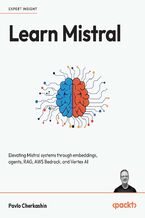 With a project-driven approach, this book equips you with the skills to build private chat systems, semantic search engines, coding assistants, and cloud deployments, so you can create AI that is practical, compliant, and production-ready.
With a project-driven approach, this book equips you with the skills to build private chat systems, semantic search engines, coding assistants, and cloud deployments, so you can create AI that is practical, compliant, and production-ready.-
-
ebook
134 pkt
Learn Mistral. Elevating Mistral systems through embeddings, agents, RAG, AWS Bedrock, and Vertex AI
(50,90 zł najniższa cena z 30 dni)
134.10 zł
149.00 zł (-10%) -
-
Promocja
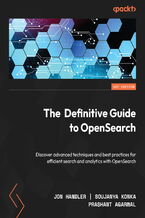 Master OpenSearch with this expert-led guide, covering installation, data ingestion, queries, dashboards, and performance optimization through hands-on tutorials and real-world examples.
Master OpenSearch with this expert-led guide, covering installation, data ingestion, queries, dashboards, and performance optimization through hands-on tutorials and real-world examples.-
-
ebook
116 pkt
The Definitive Guide to OpenSearch. Discover advanced techniques and best practices for efficient search and analytics with OpenSearch
Jon Handler, Soujanya Konka, Prashant Agrawal, Grant Ingersoll
(50,90 zł najniższa cena z 30 dni)
116.10 zł
129.00 zł (-10%) -
-
Promocja
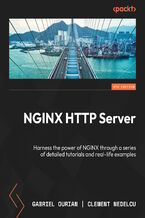 Explore the power of NGINX with this guide covering an array of essential practical topics, including securing your infrastructure with automatic TLS certificates, placing NGINX in front of your existing applications, and much more.
Explore the power of NGINX with this guide covering an array of essential practical topics, including securing your infrastructure with automatic TLS certificates, placing NGINX in front of your existing applications, and much more.-
-
ebook
125 pkt
NGINX HTTP Server. Harness the power of NGINX with a series of detailed tutorials and real-life examples - Fifth Edition
Gabriel Ouiran, Clement Nedelcu, Martin Bjerretoft Fjordvald
(29,90 zł najniższa cena z 30 dni)
125.10 zł
139.00 zł (-10%) -
-
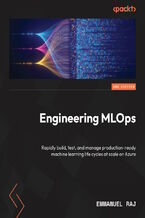 This book presents comprehensive insights into MLOps coupled with real-world examples to help you to write programs, train robust and scalable ML models, and build ML pipelines to train and deploy models securely in production.
This book presents comprehensive insights into MLOps coupled with real-world examples to help you to write programs, train robust and scalable ML models, and build ML pipelines to train and deploy models securely in production.-
-
ebook
139 pkt
W przygotowaniu
Powiadom mnie, gdy książka będzie dostępna -
-
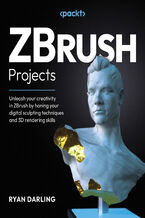 This ZBrush guide uses hands-on projects to help you master ZBrush and take your digital sculpting skills to the next level. You'll create impressive 3D models while learning advanced techniques, making your artistic journey both fun and productive.
This ZBrush guide uses hands-on projects to help you master ZBrush and take your digital sculpting skills to the next level. You'll create impressive 3D models while learning advanced techniques, making your artistic journey both fun and productive.-
-
ebook
139 pkt
W przygotowaniu
Powiadom mnie, gdy książka będzie dostępna -
-
 Google Cloud Data Architect is a field guide for data architects and engineers who want to leverage GCP for building data platforms for enterprises. This book covers both fundamental concepts as well as works as a guide to take design decisions while building for big data and advanced analytics use cases like AI/ML.
Google Cloud Data Architect is a field guide for data architects and engineers who want to leverage GCP for building data platforms for enterprises. This book covers both fundamental concepts as well as works as a guide to take design decisions while building for big data and advanced analytics use cases like AI/ML.-
-
ebook
139 pkt
W przygotowaniu
Powiadom mnie, gdy książka będzie dostępna -
-
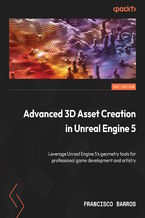 This book helps you to harness the power of Unreal Engine 5's geometry tools to create stunning 3D environments, props, and more with expert insights from Francisco Barros, who shares his secrets for crafting professional-grade assets.
This book helps you to harness the power of Unreal Engine 5's geometry tools to create stunning 3D environments, props, and more with expert insights from Francisco Barros, who shares his secrets for crafting professional-grade assets.-
-
ebook
94 pkt
W przygotowaniu
Powiadom mnie, gdy książka będzie dostępna -
-
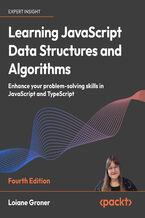 This easy-to-follow book covers essential data structures, algorithms, and their usage in the context of JavaScript and TypeScript.
This easy-to-follow book covers essential data structures, algorithms, and their usage in the context of JavaScript and TypeScript.-
-
ebook
139 pkt
W przygotowaniu
Powiadom mnie, gdy książka będzie dostępna -
-
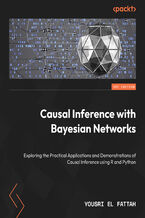 Explore the mathematical foundation of graphical models and their use for knowledge representation in causal and Bayesian networks. Delve into probabilistic inference methods in Bayesian networks. Grasp concepts of causality and treatment effects and learn the rules of causal calculus to generate probabilistic formulas for the effect of interventions in terms of the observed probabilities.
Explore the mathematical foundation of graphical models and their use for knowledge representation in causal and Bayesian networks. Delve into probabilistic inference methods in Bayesian networks. Grasp concepts of causality and treatment effects and learn the rules of causal calculus to generate probabilistic formulas for the effect of interventions in terms of the observed probabilities.-
-
ebook
139 pkt
W przygotowaniu
Powiadom mnie, gdy książka będzie dostępna -
-
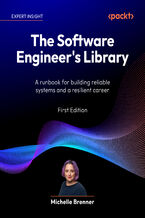 Unlock your potential to become the Senior Software Engineer everyone fights to work with! This approachable, engaging guide weaves real stories, collective wisdom, hands-on exercises, humor, and AI tips to help you and your mentees thrive
Unlock your potential to become the Senior Software Engineer everyone fights to work with! This approachable, engaging guide weaves real stories, collective wisdom, hands-on exercises, humor, and AI tips to help you and your mentees thrive-
-
ebook
129 pkt
W przygotowaniu
Powiadom mnie, gdy książka będzie dostępna -
Dzięki opcji "Druk na żądanie" do sprzedaży wracają tytuły Grupy Helion, które cieszyły sie dużym zainteresowaniem, a których nakład został wyprzedany.
Dla naszych Czytelników wydrukowaliśmy dodatkową pulę egzemplarzy w technice druku cyfrowego.
Co powinieneś wiedzieć o usłudze "Druk na żądanie":
- usługa obejmuje tylko widoczną poniżej listę tytułów, którą na bieżąco aktualizujemy;
- cena książki może być wyższa od początkowej ceny detalicznej, co jest spowodowane kosztami druku cyfrowego (wyższymi niż koszty tradycyjnego druku offsetowego). Obowiązująca cena jest zawsze podawana na stronie WWW książki;
- zawartość książki wraz z dodatkami (płyta CD, DVD) odpowiada jej pierwotnemu wydaniu i jest w pełni komplementarna;
- usługa nie obejmuje książek w kolorze.
Masz pytanie o konkretny tytuł? Napisz do nas: sklep@ebookpoint.pl
Książka drukowana









Oceny i opinie klientów: Mastering Object-oriented Python. If you want to master object-oriented Python programming this book is a must-have. With 750 code samples and a relaxed tutorial, it’s a seamless route to programming Python Steven F. Lott
(0)